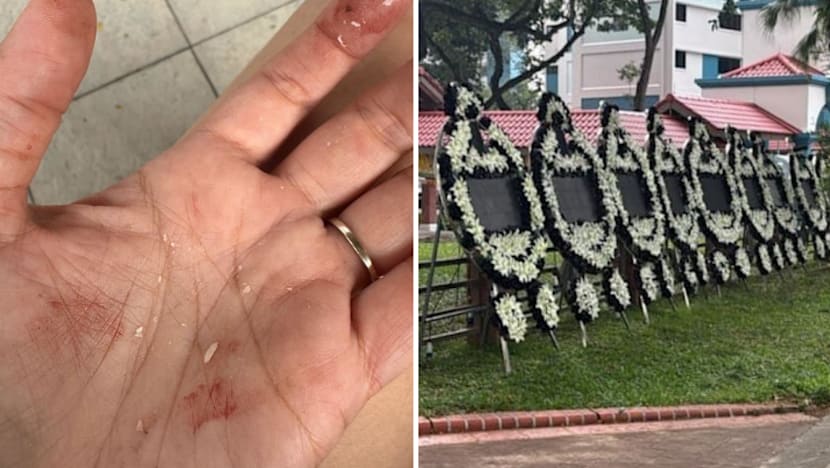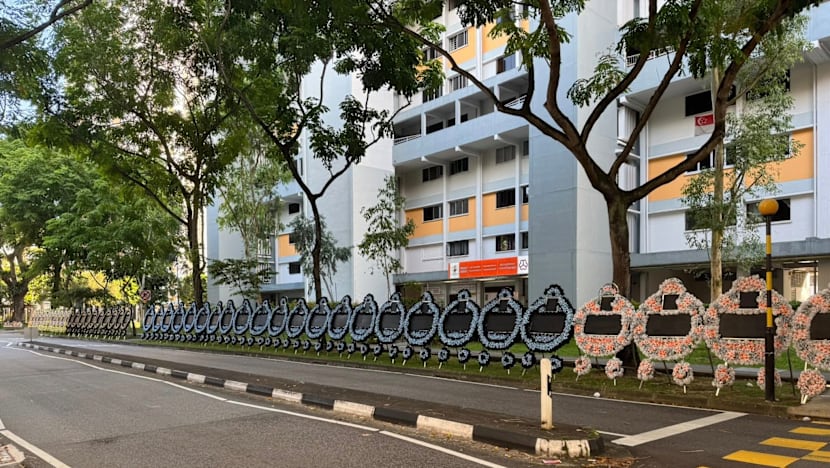Hit by a falling LED wreath: Enforcement gaps, safety lapses persist 3 years after tightened rules
One woman suffered broken teeth when a heavy LED wreath toppled onto her, spotlighting lapses in funeral wake safety despite guidelines introduced in 2022.

Left: Fragments of Mrs Khoo's teeth and blood on her hand after she was hit by an LED wreath. Right: The row of LED wreaths secured to barriers after the accident. (Photos: Mrs Khoo)

This audio is generated by an AI tool.
SINGAPORE: Mrs A Khoo had just celebrated Children's Day on Oct 2 with her two younger children and was walking home with lunch for her eldest son.
Along the pedestrian walkway in her Ang Mo Kio estate, a row of about 10 LED wreaths had been lined up on a grass patch for a nearby wake.
As she walked past, a gust of wind struck. Several LED wreaths came crashing down, with one so heavy it pinned the 44-year-old part-time sales administrator to the ground, chipping off half of her two front teeth and bruising her cheek and shoulder.
Two people from the wake rushed over to lift the wreath off her and offered to call an ambulance. She declined, still unsure of the extent of her injuries, and phoned her husband instead.
"I was not even able to describe to (him) what exactly happened. I just told him: 'Can you please just get down here,'" Mrs Khoo told ΒιΆΉ in an interview last week.
But what struck her most was not the pain β it was the finger-pointing among those at the scene.
"Everyone was just pushing the blame to each other on why the wreath fell," she said. The bereaved family claimed the wreaths were gifts from friends, while staffers from the funeral home said they did not place the wreaths near the walkway.
Some people at the wake also made light of her injuries, brushing the incident off as "an act of God", Mrs Khoo said.
She was on painkillers for nearly two weeks and could barely move her hand. Multiple dental visits followed, including one where a nerve had to be removed from her gum.
"I was constantly in pain," Mrs Khoo said. To top it off, it was embarrassing whenever she opened her mouth with half her front teeth broken off.
Mrs Khoo has since fitted temporary "aesthetic teeth", but still cannot eat without pain nearly two months after the incident. She has spent about S$1,000 (US$765) on dental work and faces another S$2,000 to S$3,000 for root canals and crowns.
None of the parties involved have contacted her since the accident.

"It's a blessing I'm an able-bodied, healthy adult," she said. "What happens if it's an elderly or young child? Are the (authorities) really going to wait till there's a fatality or very serious injuries before they do something?"
Her husband, Mr Khoo, a 56-year-old private-hire driver, questioned whether any risk assessments were conducted for such displays. βTo me, this object is a hazard. But nobodyβs looking at it from that point of view,β he said.
When ΒιΆΉ contacted Ang Mo Kio Town Council, its spokesperson said it was only informed after the accident that the wreaths had been relocated by members of the bereaved family.
The town council's property team responded on-site after the accident, and vendors engaged by the family inspected the wreaths to ensure they were properly secured.
The town council said its role was to brief applicants on the guidelines for using common property for funeral set-ups, including outdoor displays such as LED wreaths.
"Applicants acknowledge these guidelines when applying to use the common areas," the spokesperson said.
GUIDELINES INTRODUCED IN 2022
Mrs Khoo's accident came three years after guidelines were introduced to limit the use of light-emitting wreaths at funerals following concerns about light and noise pollution and safety risks.
Under the guidelines, jointly developed by the National Environment Agency (NEA) and the Association of Funeral Directors Singapore, there must be at least 1.5m of walking space to accommodate pedestrians on foot or in wheelchairs if LED wreaths are placed within common spaces such as walkways.
Only up to 10 LED wreaths are allowed at each wake, and they must be switched off between 10pm and 7am.
But compliance has been inconsistent. Earlier this month, 70 LED wreaths for one wake lined Gloucester Road opposite Pek Kio Community Centre. Some toppled onto the road, blocking traffic.
The family involved repeatedly ignored reminders to remove the excess wreaths and was eventually fined.
WHO'S RESPONSIBLE
Views differ within the funeral industry on who is responsible for the safe use of LED wreaths.
A spokesperson for the Association of Funeral Directors Singapore told ΒιΆΉ that residents applying for permits to use Housing Board void decks for occasions such as funerals are ultimately accountable for the safety and conduct of the event. They must also comply with the town councilβs terms and conditions.
This includes keeping noise levels down, being considerate to neighbours and limiting the number of LED wreaths to within the recommended maximum to prevent accidents or disturbances to other residents and the public.
Objects installed in common spaces should not pose safety risks. LED wreaths placed in non-sheltered areas face a higher risk of being affected by bad weather, which could cause them to topple or trigger electrical faults.
At the same time, LED wreath suppliers also share the responsibility of ensuring that their installations do not cause any accidents or breach safety requirements.
"The recent incident highlights the importance of the responsibility of the LED wreath companies, mindfulness of the residents and the senders," said the spokesperson, adding that those injured by a falling wreath should seek legal advice.
Funeral directors ΒιΆΉ spoke to pointed to third-party LED wreath suppliers engaged by well-wishers, who may not know about the 10-wreath limit.
Families often find it difficult to refuse these gestures of goodwill, even when they exceed the quota.
Funeral homes are not always informed in advance or present throughout the entire wake, making it difficult to track when the wreaths arrive. While they remind families about the rules, the decision to comply lies with the family.
"We can't force them. We are not any government authorities to do that," said Ms Harmony Tee, funeral director of Harmony Funeral Care. "We can only advise them and tell them of the regulations, but whether they choose to follow, it's up to them at the end of the day."
Mr Vincent Ng, director of A.LifeGrad Funeral Services, said he cautions families that town councils may issue fines if the limit is exceeded. Some simply reply with an "okay, ask them to fine," he said.
Passion Bereavement Care chief executive Deborah Kang said her clients have generally complied, with fewer funerals now featuring LED wreaths. The company, which conducts Christian, Catholic and free-thinker services, had no more than two wakes this year with electronic wreaths β all within the limit.
She attributes this drop to her company's practice of informing families early to avoid added "unhappiness" during an already difficult time.
Meanwhile, LED wreath suppliers like Mr Martin Loke find themselves caught between following rules and meeting customer expectations.
Mr Loke, owner of DMK Services, said town councils typically brief families on the 10-wreath limit. But even when it goes beyond that, it is "very, very hard to say no", he said.
It would be like pushing the job away, which affects future orders. But more than that, he would be rejecting someone's well-wishes to their loved ones.
"Someone sends condolences to you, but you say you don't want β¦ (What if) one day people do the same to you?" he said.
Mr Loke added that his company consults families about excess wreaths and proceeds with their permission to set them up on grass patches, tying them front and back to prevent them from falling.
The supplier also makes multiple checks during the wake to ensure they are secure.
He acknowledged that suppliers like himself are responsible if a wreath becomes loose and falls on pedestrians, though he said his company has not received any complaints.
Referring to the Pek Kio case, he said such incidents give LED wreath suppliers a bad name when others "spoil the market".
βIt affects our business. But what to do? We cannot ask customers not to call them. So we just do our part,β he said.

IS A BAN THE ANSWER?
Rather than LED wreaths, funeral directors like Ms Kang encourage clients to inform their relatives to send fresh flower wreaths instead.
The flowers not only beautify the funeral space but can also be placed inside the casket on the last day of the wake, which is "more meaningful", said Ms Kang.
Ms Tee and Mr Ng felt that LED wreaths are largely about grandeur, serving as a visible gesture from well-wishers to show their support.
Both pointed out that the wreaths often cause power trips, and Mr Ng added that bad weather has led to wreaths toppling onto walkways β as in Mrs Khooβs case.
Asked how the situation could be improved, Ms Kang called for clearer communication of the rules, noting that some families may be unaware of them or simply overlook them.
Mr Ng took a firmer view, saying the government should ban LED wreaths altogether, instead of restricting them to 10.
The A.LifeGrad director said funeral directors are in a "difficult position", as the responsibility for the wreaths often falls on them, even though it is not within their control. "It's not fair to funeral directors. They need to oversee too many things," said Mr Ng.
"In order to avoid any conflicts like 'funeral directors are not doing their work', might as well just ban the wreaths."










